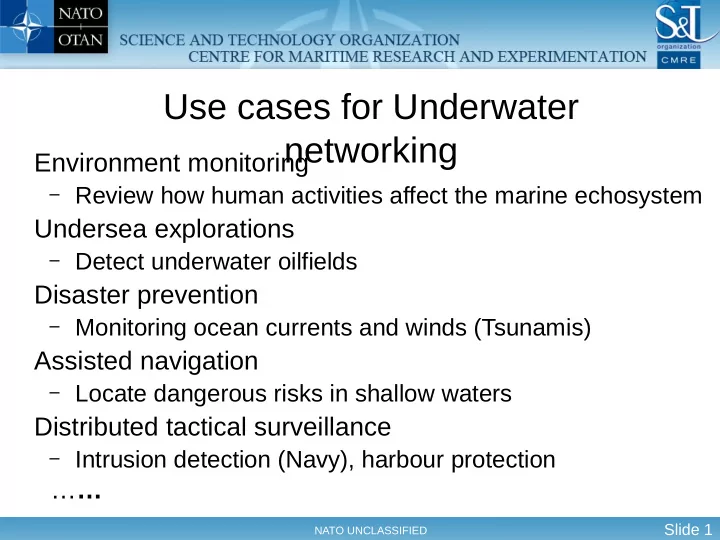

Use cases for Underwater networking Environment monitoring – Review how human activities affect the marine echosystem Undersea explorations – Detect underwater oilfields Disaster prevention – Monitoring ocean currents and winds (Tsunamis) Assisted navigation – Locate dangerous risks in shallow waters Distributed tactical surveillance – Intrusion detection (Navy), harbour protection … … Slide 1 NATO UNCLASSIFIED
The Requirement for Underwater Communications • We don’t like our autonomous vehicles to be too autonomous • Safety of operations • Real-time data is usually a requirement • Cooperation, in general, requires some kind of explicit information exchange • Increased number of assets being deployed (currently from few up to 15 underwater and surface nodes) Slide 2 NATO UNCLASSIFIED
UW Communications Channels: Qualitative overview • Low power • Small hardware • High Bandwidth G b/s • Requires line of OPTICA sight • Unaffected by • Requires tight turbidity ,marine alignment of end L fouling or acoustic points • Established noise • Susceptible to technology • Crosses the air- marine fouling • Full networking water boundary • Sensitive to Bandwidt support • High bandwidth suspended particles ELECTROMAGNE • Supports ranges of and turbidity • Very limited 10s of Km • Sensitive to networking support TIC pressure and h for underwater temperature communication gradients • Loop antennas far 10s • Performance from ideal for small Kb/s degrades in shallow AUV integration water • Limited bandwidth ACOUSTIC 10s b/s 10s m 100s m 10s Km Range Slide 3 NATO UNCLASSIFIED
Acoustic communications: The Channel “Advances in Integrating Autonomy with Acoustic Communications for Intelligent Networks of Marine Robots”,Toby Schneider, PhD thesis, 2013 Slide 4 NATO UNCLASSIFIED
Acoustic communications: The Channel • Slow speed of propagation: five orders of magnitude lower than in Radio Frequency) ● High Doppler shifts (example: v=2m/s, f=25 kHz, shift = 33 Hz) • Spreading Loss ● Energy covering a big volume • Absorption Loss (Frequency Dependent) ● Losses from energy propagation/ transfer • Scattering Loss ● Surface scattering – rough sea surface introduces rapidly fluctuating arrivals ● Bubble layer scattering Slide 5 NATO UNCLASSIFIED
Acoustic communications: The Channel • Low Bandwidth • Ambient noise and high interference level • High bit errors and temporary loss of connectivity with possible asymmetric links • Waveguide, multipath, shadow zones ● Reflections from bottom and surface ● Refraction form spatially varying sound speed ● Masses of water with different characteristics ● Imposes multipath and time spread –ISI Slide 6 NATO UNCLASSIFIED
Channel Impulse Responses : Examples Cyclic arrival agreeing with the Wind burst at around t=25 seconds period of the dominant waves “Channel Sounding For Acoustic Communications: Techniques and Shallow Water Examples”, Paul Van Walree, Technical Report 2011 Slide 7 NATO UNCLASSIFIED
What a very benign acoustic channel will do to your signals “Underwater Acoustic Communications Performance Modeling in Support of Ad Hoc Network Design”, Fox, W. L J; Arabshahi, P.; Roy, S.; Parrish, N., OCEANS 2007 , vol., no., pp.1,5, Sept. 29 2007-Oct. 4 2007 Slide 8 NATO UNCLASSIFIED
UW Acoustics Physical Layer Performance “The state of the art in underwater acoustic telemetry” Kilfoyle, D.B.; Baggeroer, A.B.; MIT & Woods Hole Oceanogr. Instn. Joint Program in Oceanogr. Eng., Woods Hole Oceanogr. Instn., MA IEEE Journal of Oceanic Engineering, Jan 2000 Slide 9 NATO UNCLASSIFIED
Challenges • Interoperability is nonexistent ! • Software architectures based on the OSI stack fall short of providing cross-layer information essential for achieving optimized solutions • There is no single adopted way to simulate the acoustic channel • Usually simulations fail to fully capture underwater channel dynamics resulting in oversimplified scenarios • Going at sea is expensive. Doing it in a controlled way even more so. • Reliable and robust multi-hop communication coping with channel dynamics Slide 10 NATO UNCLASSIFIED
Trends • Interoperability will hopefully come ! JANUS is here, hopefully promulgated as a standard soon. • Improved data throughput to be pursued by: More sophisticated modulation and coding schemes, signal processing – techniques. Multi-carrier systems, – Multi-modality, hybrid systems – • Software-defined architectures will improve sharing of solutions and promote a true “survival of the fittest” in terms of protocol solutions • Network security for underwater communications • Combination of sensing, networking, communication and navigation capabilities to improve underwater node operations • Network coding, data compression and DTN solutions Slide 11 NATO UNCLASSIFIED
Recommend
More recommend